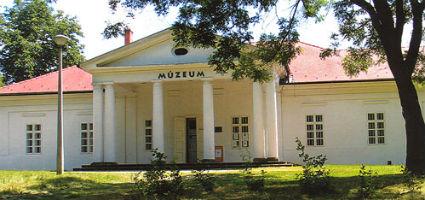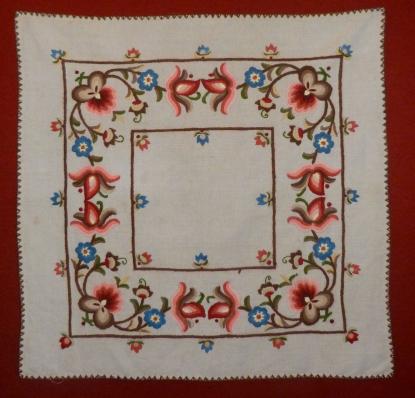2024. April 29. Monday
Pál Kiss Museum - Tiszafüred
 |
Address: 5350, Tiszafüred Tariczky sétány 6.
Phone number: (59) 352-106
E-mail: kisspalmuz@gmail.com
Opening hours: Tue-Sat 9-12, 13-17
|
The exhibition has closed for visitors.
2014.02.04. - 2014.02.28.
Museum tickets, service costs:
|
Ticket for adults
|
500 HUF
|
/ capita
|
|
Group ticket for adults
(min. 10 people)
|
150 HUF
|
/ capita
|
|
Ticket for students
|
250 HUF
|
/ capita
|
|
Ticket for pensioners
|
250 HUF
|
/ capita
|
|
Ticket for families
(2 adults + max. 3 children)
|
750 HUF
|
/ family
|
|
Program ticket
|
300 HUF
|
/ capita
|
|
Season ticket
|
1000 HUF
|
|
|
Group guide
(max. 40 people)
|
2000 HUF
|
/ group
|
|
Photography
|
1000 HUF
|
|
|
Video
|
1000 HUF
|
Here we present a tablecloth made by the technique of the so-called Cumanian Embroidery. This embroidery technique is named after the Cumanian people (the Cumans) who are Turkic origin people and had settled in the Eastern part of Hungary before the Mongol invasion in 1241. Now their destendences are living in the Greater Cumanian settlements (in Karcag, Kisújszállás, Túrkeve, Kunhegyes, Kunmadaras and their surroundings). These settlements are famous for the tradition of making Cumanian embroidery.

This is a bright, colorful peasant embroidery. It is a version of the satin stitch, it is the fake flat stitch (“hamis laposöltés”). Its colors are varies. The most popular colors of this embroidery are pink, cherryred, red, brown, green, blue or sometimes black and the different shades of these. This embroidery varies not only in colors, but in the composition of the stitches as well. The most general and the most classic is the three-part division. According to this, the main motif is placed in the centre of the surface to be ornamented. This motif is a stylized flower, such as tulip or rose and the composition has other ornaments on the both sides of the main motif. The central motif is closed off at the top and at the bottom by a border, which is narrower than the former.
These traditional embroided desings were placed on the end of the pillow facing outwards on the bed. There are many original pillow-ends (“párnavég”) in the museums from the 18th and 19 centuries made by this technique.
Our presented tablecloth is a rather new one, made in 1976. It was used for covering a square table. This surface is not a traditional form of this embroidery that is why the original composition of motifs is rearranged into a new form. We see that due to the square form the main composition is repeated four times in the four corners of the table-cloth.
The central motif of this tablecloth is the rose. It is in the corners. A great many colors are used in shades from light to dark. There is a pale pink, a pink, a dark pink, a red, and a cherryred. Due to the concentric design, there are symmetrical motifs on both sides of the rose. There are tulips with 5 petals, colorful leaves and seven-petalled, stylized blue flowers. The petals of the tulip are coloured in three shades of pink and in three shades of brown. In consequence it is seem to be mooving that is why it is called ’dancing tulip’. The central motif is closed off by the brown border lines with smal three-petalled stylized flowers.
This hand made table-cloth was embroided by Ms Nagy Ferencné, folk artist of the former Folk-Art and Homecraft Cooperative of Karcag in 1976.
By Vadász, István

This is a bright, colorful peasant embroidery. It is a version of the satin stitch, it is the fake flat stitch (“hamis laposöltés”). Its colors are varies. The most popular colors of this embroidery are pink, cherryred, red, brown, green, blue or sometimes black and the different shades of these. This embroidery varies not only in colors, but in the composition of the stitches as well. The most general and the most classic is the three-part division. According to this, the main motif is placed in the centre of the surface to be ornamented. This motif is a stylized flower, such as tulip or rose and the composition has other ornaments on the both sides of the main motif. The central motif is closed off at the top and at the bottom by a border, which is narrower than the former.
These traditional embroided desings were placed on the end of the pillow facing outwards on the bed. There are many original pillow-ends (“párnavég”) in the museums from the 18th and 19 centuries made by this technique.
Our presented tablecloth is a rather new one, made in 1976. It was used for covering a square table. This surface is not a traditional form of this embroidery that is why the original composition of motifs is rearranged into a new form. We see that due to the square form the main composition is repeated four times in the four corners of the table-cloth.
The central motif of this tablecloth is the rose. It is in the corners. A great many colors are used in shades from light to dark. There is a pale pink, a pink, a dark pink, a red, and a cherryred. Due to the concentric design, there are symmetrical motifs on both sides of the rose. There are tulips with 5 petals, colorful leaves and seven-petalled, stylized blue flowers. The petals of the tulip are coloured in three shades of pink and in three shades of brown. In consequence it is seem to be mooving that is why it is called ’dancing tulip’. The central motif is closed off by the brown border lines with smal three-petalled stylized flowers.
This hand made table-cloth was embroided by Ms Nagy Ferencné, folk artist of the former Folk-Art and Homecraft Cooperative of Karcag in 1976.
By Vadász, István
